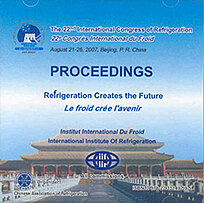
Résumé
Unfrozen water content is essential for analyses of cell livability during cryopreservation protocols as well as cryosurgery. This study shows a new method for studying the unfrozen water content of biological tissues during freezing. Stepwise scanning-DSC (SW-DSC) is firstly introduced to study the unfrozen water content of rabbit aorta during freezing. This study provides insight into the effect of presence of cryoprotectants (CPA) on unfrozen water content further. Results show that the unfrozen water content of rabbit aorta can be precisely determined by the technique of SW-DSC within a cryogenic temperature range(such as 0 to -50°C). And, unfrozen water content of fresh aorta (i.e. without CPA) decreases rapidly as temperature lowing (e.g. unfrozen water content changes from 1 to 0.32). However, fresh sample permeated by 10% (v/v) dimethylsulfoxide (DMSO, a kind of CPA) solution, unfrozen water content of the sample decreases slowly(e.g. from 1 to 0.45), which means that the unfrozen water content increases significantly with DMSO concentration increasing at the same temperature due to the strong hydration action of DMSO.
Documents disponibles
Format PDF
Pages : ICR07-C1-802
Disponible
Prix public
20 €
Prix membre*
Gratuit
* meilleur tarif applicable selon le type d'adhésion (voir le détail des avantages des adhésions individuelles et collectives)
Détails
- Titre original : A new method for studying unfrozen water content of biological tissues during freezing.
- Identifiant de la fiche : 2007-2825
- Langues : Anglais
- Source : ICR 2007. Refrigeration Creates the Future. Proceedings of the 22nd IIR International Congress of Refrigeration.
- Date d'édition : 21/08/2007
Liens
Voir d'autres communications du même compte rendu (839)
Voir le compte rendu de la conférence
Indexation
- Thèmes : Influence du froid sur les cellules, tissus et organes
- Mots-clés : Cellule; Tissu; Cryoconservation; Congélation; Eau
-
PRACTICAL METHODS FOR PRESERVATION OF CULTURED ...
- Auteurs : OHNISHI K.
- Date : 20/05/1985
- Langues : Anglais
- Source : Fundamentals and Applications of Freeze-Drying to Biological Materials, Drugs and Foodstuffs.
- Formats : PDF
Voir la fiche
-
Observations of proliferation and division of f...
- Auteurs : SUMIDA S., KITAMURA T., KAIHOU T., et al.
- Date : 15/05/2017
- Langues : Anglais
- Source : Cryogenics 2017. Proceedings of the 14th IIR International Conference: Dresden, Germany, Mai 15-19, 2017.
- Formats : PDF
Voir la fiche
-
Engineering aspects of cryobiology.
- Auteurs : WOLFINBARGER L. Jr, SUTHERLAND V., BRAENDLE L., SUTHERLAND G.
- Date : 17/07/1996
- Langues : Anglais
- Source : Advances in cryogenic engineering.
Voir la fiche
-
From the tissue bank to the tissue establishment.
- Auteurs : MERICKA P., STRAKOVÁ H., HORYNOVÁ A.
- Date : 21/04/2008
- Langues : Anglais
- Source : Cryogenics 2008. Proceedings of the 10th IIR International Conference
- Formats : PDF
Voir la fiche
-
ASPECTS MORPHOLOGIQUES DES EFFETS FRIGORIFIQUES...
- Auteurs : JURCENKO T. N.
- Date : 02/08/1987
- Langues : Russe
Voir la fiche
